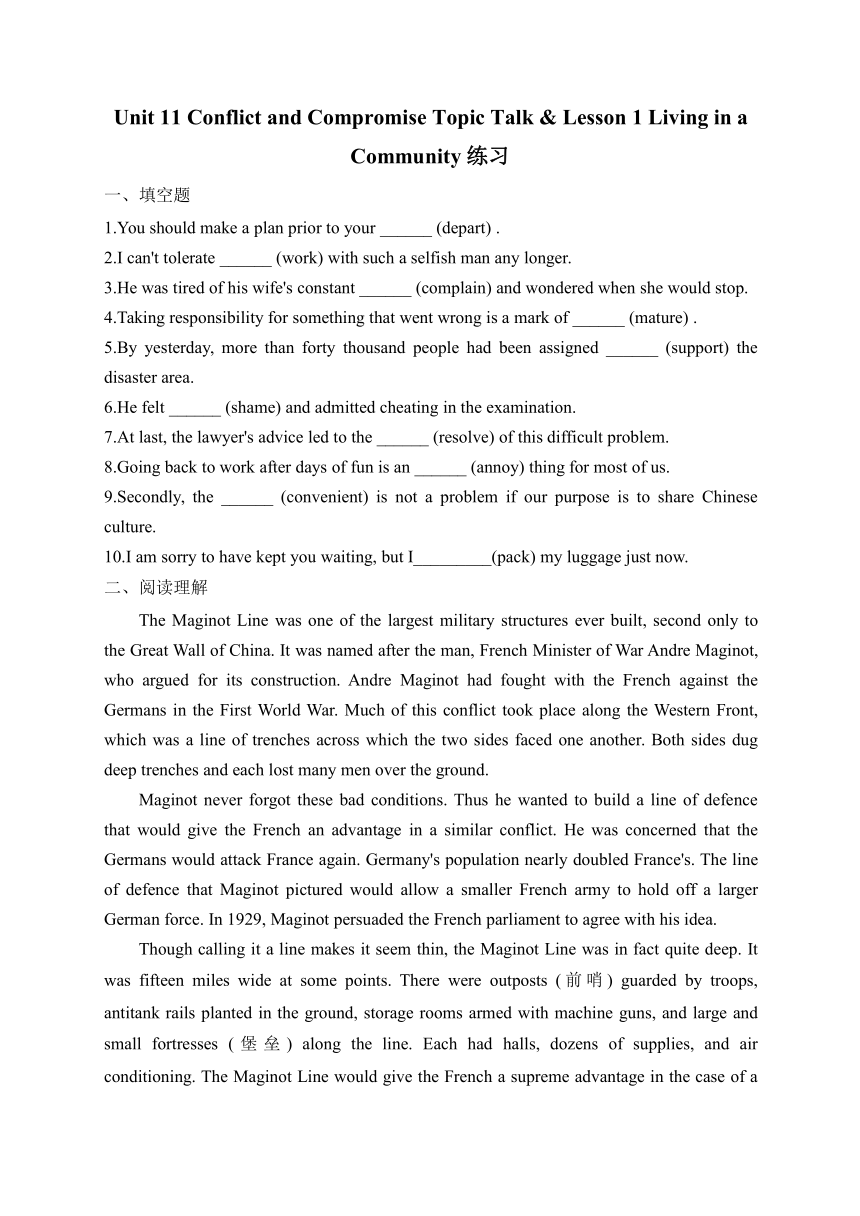
Unit 11 Conflict and Compromise Topic Talk & Lesson 1 Living in a Community 练习 一、填空题 1.You should make a plan prior to your _____ (depart) . 2.I can't tolerate _____ (work) with such a selfish man any longer. 3.He was tired of his wife's constant _____ (complain) and wondered when she would stop. 4.Taking responsibility for something that went wrong is a mark of _____ (mature) . 5.By yesterday, more than forty thousand people had been assigned _____ (support) the disaster area. 6.He felt _____ (shame) and admitted cheating in the examination. 7.At last, the lawyer's advice led to the _____ (resolve) of this difficult problem. 8.Going back to work after days of fun is an _____ (annoy) thing for most of us. 9.Secondly, the _____ (convenient) is not a problem if our purpose is to share Chinese culture. 10.I am sorry to have kept you waiting, but I_____(pack) my luggage just now. 二、阅读理解 The Maginot Line was one of the largest military structures ever built, second only to the Great Wall of China. It was named after the man, French Minister of War Andre Maginot, who argued for its construction. Andre Maginot had fought with the French against the Germans in the First World War. Much of this conflict took place along the Western Front, which was a line of trenches across which the two sides faced one another. Both sides dug deep trenches and each lost many men over the ground. Maginot never forgot these bad conditions. Thus he wanted to build a line of defence that would give the French an advantage in a similar conflict. He was concerned that the Germans would attack France again. Germany's population nearly doubled France's. The line of defence that Maginot pictured would allow a smaller French army to hold off a larger German force. In 1929, Maginot persuaded the French parliament to agree with his idea. Though calling it a line makes it seem thin, the Maginot Line was in fact quite deep. It was fifteen miles wide at some points. There were outposts (前哨) guarded by troops, antitank rails planted in the ground, storage rooms armed with machine guns, and large and small fortresses (堡垒) along the line. Each had halls, dozens of supplies, and air conditioning. The Maginot Line would give the French a supreme advantage in the case of a head-on (正面的) attack by the Germans. Unfortunately for the French, the Germans did not attack head-on. They arranged for a small army in front of the line to attract the French. While the French were waiting, the Germans sent a larger force through Belgium, which is France's northeastern neighbor. The French did have some defences along their border with Belgium, but this part of the Maginot Line had not been strengthened. The Germans quickly attacked these defences. Within five days of their initial attack, they were well into France. Once they were in France, the Germans attempted to capture the main fortresses along the Maginot Line. Soon, Paris was taken and the Maginot Line turned into a failed pro ... ...
~~ 您好,已阅读到文档的结尾了 ~~

